Graph Linear Equations in Two Variables
Learning Objectives
- Create a table of ordered pairs from a two-variable linear equation
- Graph a two-variable linear equation using a table of ordered pairs
- Determine whether an ordered pair is a solution of an equation
- Recognize when an ordered pair is a y-intercept or an x-intercept
- Graph a linear equation using x- and y-intercepts
Plotting points to graph linear relationships
| x-coordinate | y-coordinate |
| 0 | 0 |
| 1 | 2 |
| 2 | 4 |
| 3 | 6 |
| 4 | 8 |
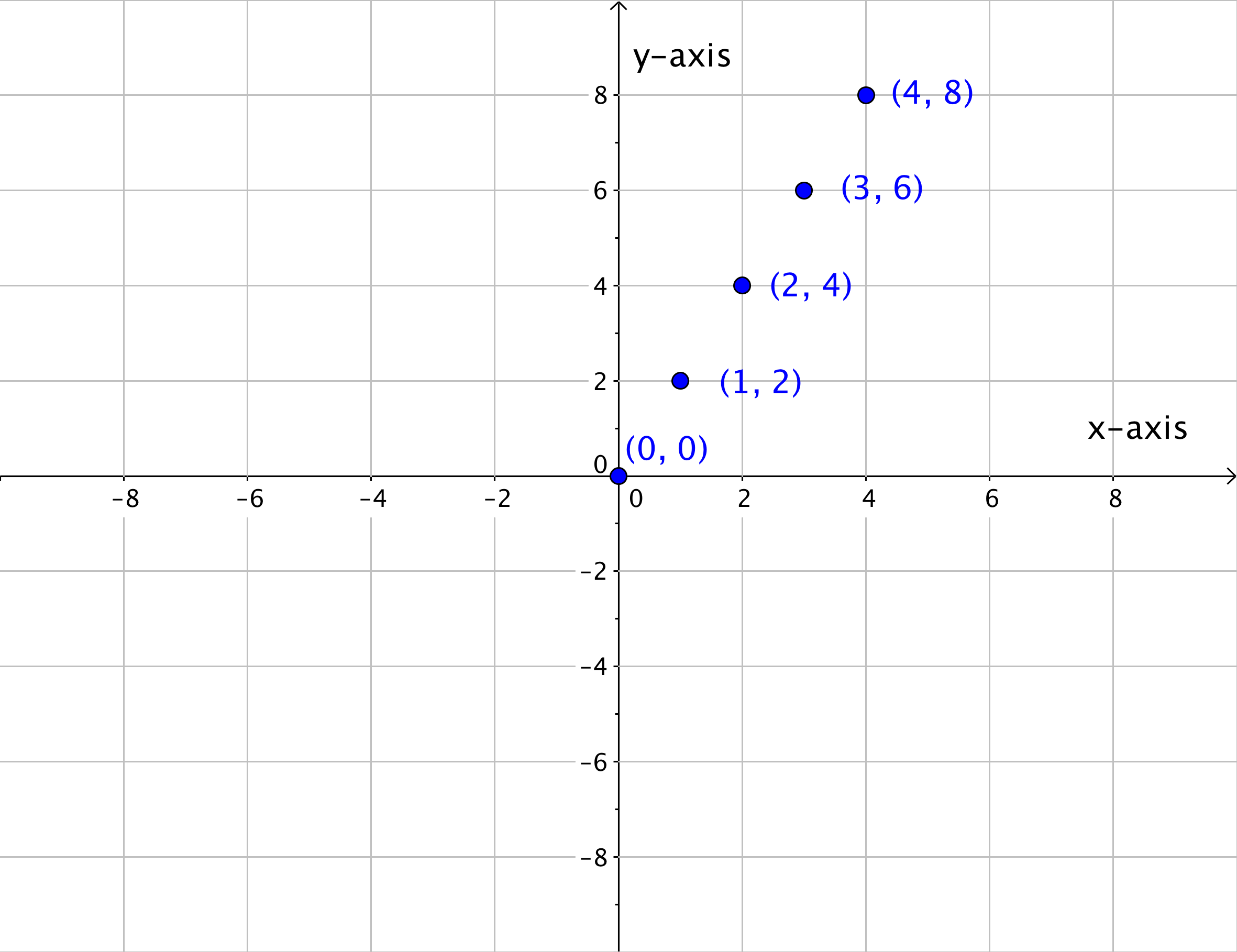 Once you know the pattern that relates the x- and y-values, you can find a y-value for any x-value that lies on the line. So if the rule of this pattern is that each y-coordinate is twice the corresponding x-value, then the ordered pairs (1.5, 3), (2.5, 5), and (3.5, 7) should all appear on the line too, correct? Look to see what happens.
Once you know the pattern that relates the x- and y-values, you can find a y-value for any x-value that lies on the line. So if the rule of this pattern is that each y-coordinate is twice the corresponding x-value, then the ordered pairs (1.5, 3), (2.5, 5), and (3.5, 7) should all appear on the line too, correct? Look to see what happens.
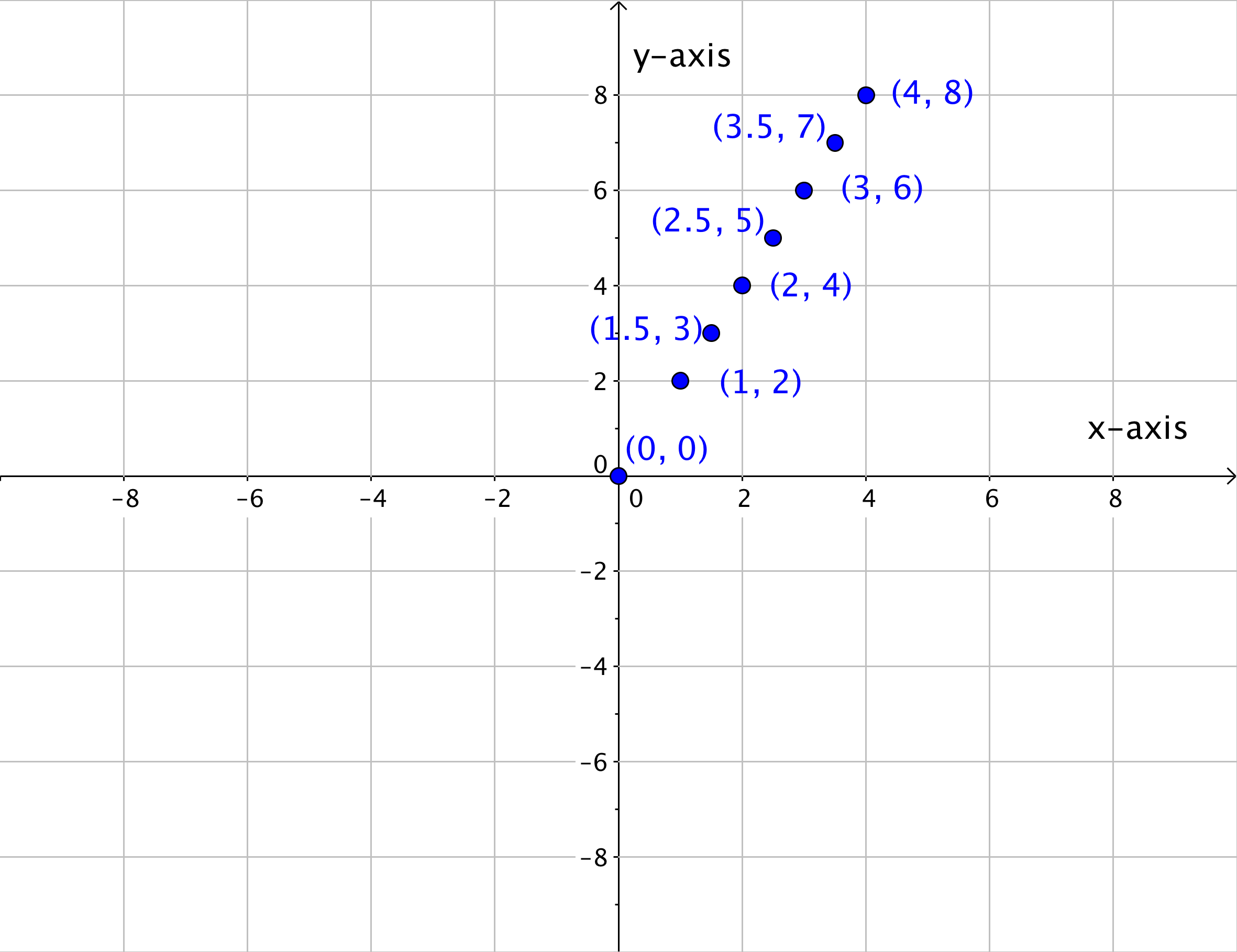 If you were to keep adding ordered pairs (x, y) where the y-value was twice the x-value, you would end up with a graph like this.
If you were to keep adding ordered pairs (x, y) where the y-value was twice the x-value, you would end up with a graph like this.
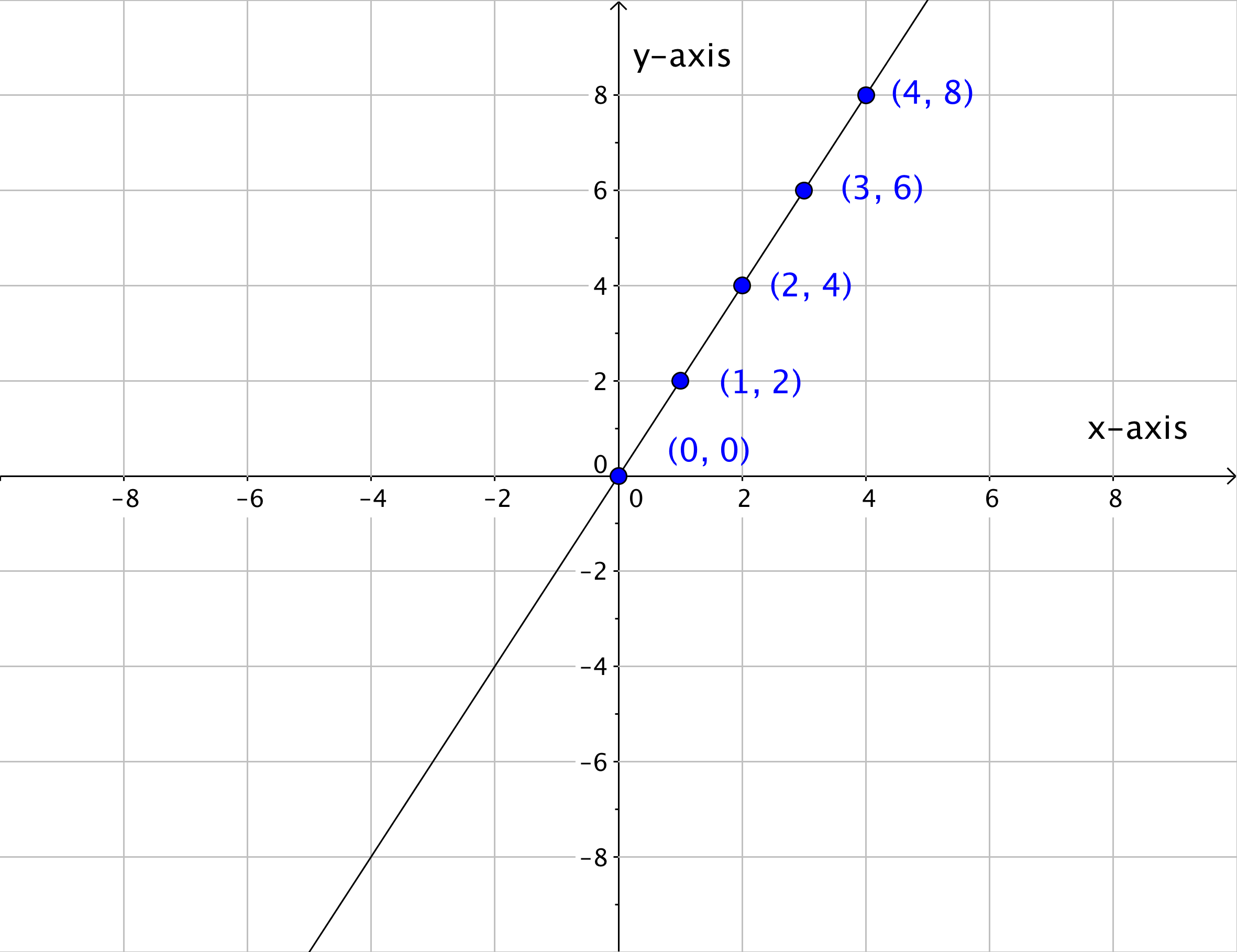 Look at how all of the points blend together to create a line. You can think of a line, then, as a collection of an infinite number of individual points that share the same mathematical relationship. In this case, the relationship is that the y-value is twice the x-value.
There are multiple ways to represent a linear relationship—a table, a linear graph, and there is also a linear equation. A linear equation is an equation with two variables whose ordered pairs graph as a straight line.
There are several ways to create a graph from a linear equation. One way is to create a table of values for x and y, and then plot these ordered pairs on the coordinate plane. Two points are enough to determine a line. However, it’s always a good idea to plot more than two points to avoid possible errors.
Then you draw a line through the points to show all of the points that are on the line. The arrows at each end of the graph indicate that the line continues endlessly in both directions. Every point on this line is a solution to the linear equation.
Look at how all of the points blend together to create a line. You can think of a line, then, as a collection of an infinite number of individual points that share the same mathematical relationship. In this case, the relationship is that the y-value is twice the x-value.
There are multiple ways to represent a linear relationship—a table, a linear graph, and there is also a linear equation. A linear equation is an equation with two variables whose ordered pairs graph as a straight line.
There are several ways to create a graph from a linear equation. One way is to create a table of values for x and y, and then plot these ordered pairs on the coordinate plane. Two points are enough to determine a line. However, it’s always a good idea to plot more than two points to avoid possible errors.
Then you draw a line through the points to show all of the points that are on the line. The arrows at each end of the graph indicate that the line continues endlessly in both directions. Every point on this line is a solution to the linear equation.
Example
Graph the linear equation [latex]y=2x+3[/latex].Answer: Evaluate [latex]y=2x+3[/latex] for different values of x, and create a table of corresponding x and y values.
| x values | [latex]2x+3[/latex] | y values |
| 0 | 2(0) + 3 | 3 |
| 1 | 2(1) + 3 | 5 |
| 2 | 2(2) + 3 | 7 |
| 3 | 2(3) + 3 | 9 |
(0, 3)
(1, 5)
(2, 7)
(3, 9)
Convert the table to ordered pairs. Plot the ordered pairs.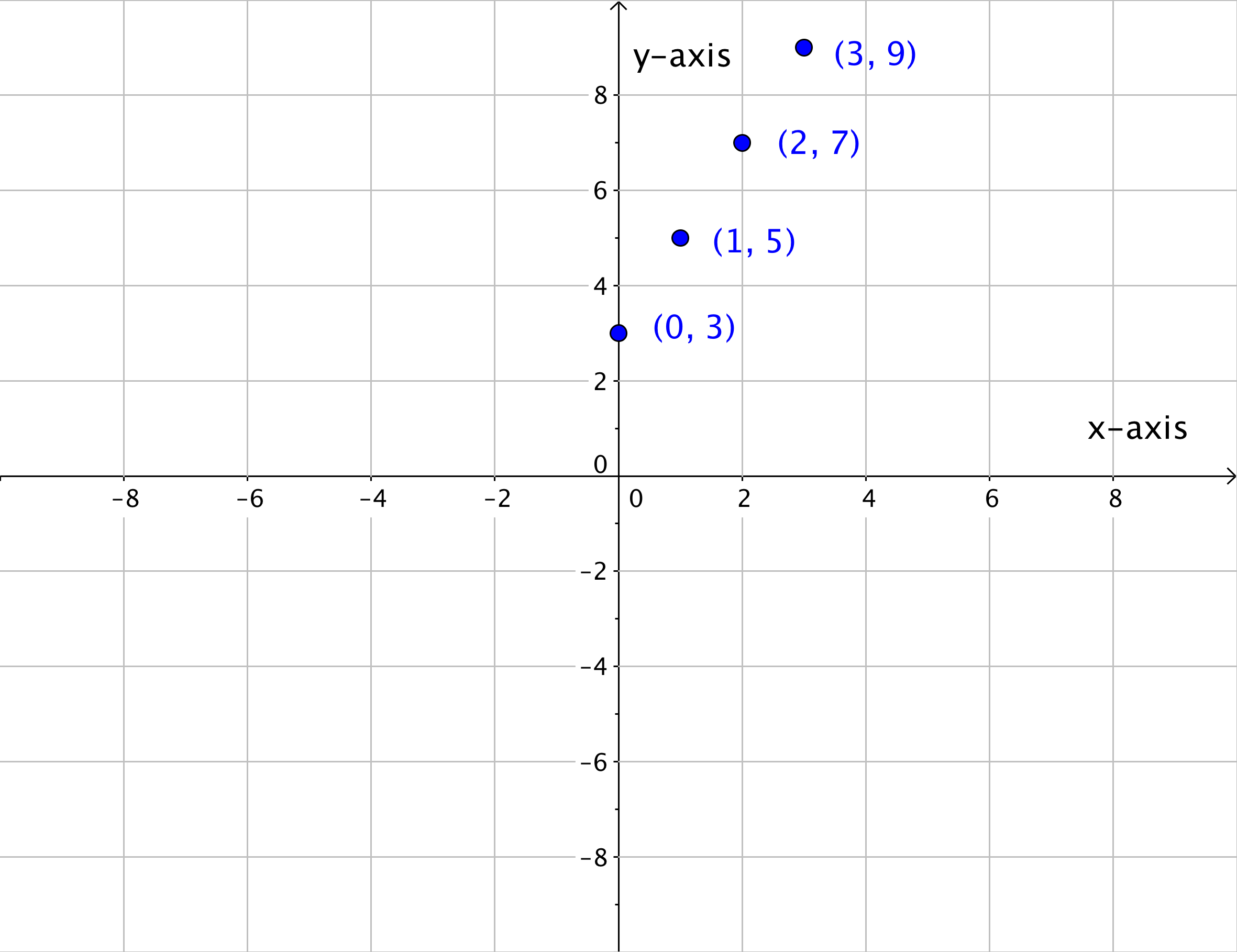 Draw a line through the points to indicate all of the points on the line.
Draw a line through the points to indicate all of the points on the line.
Answer
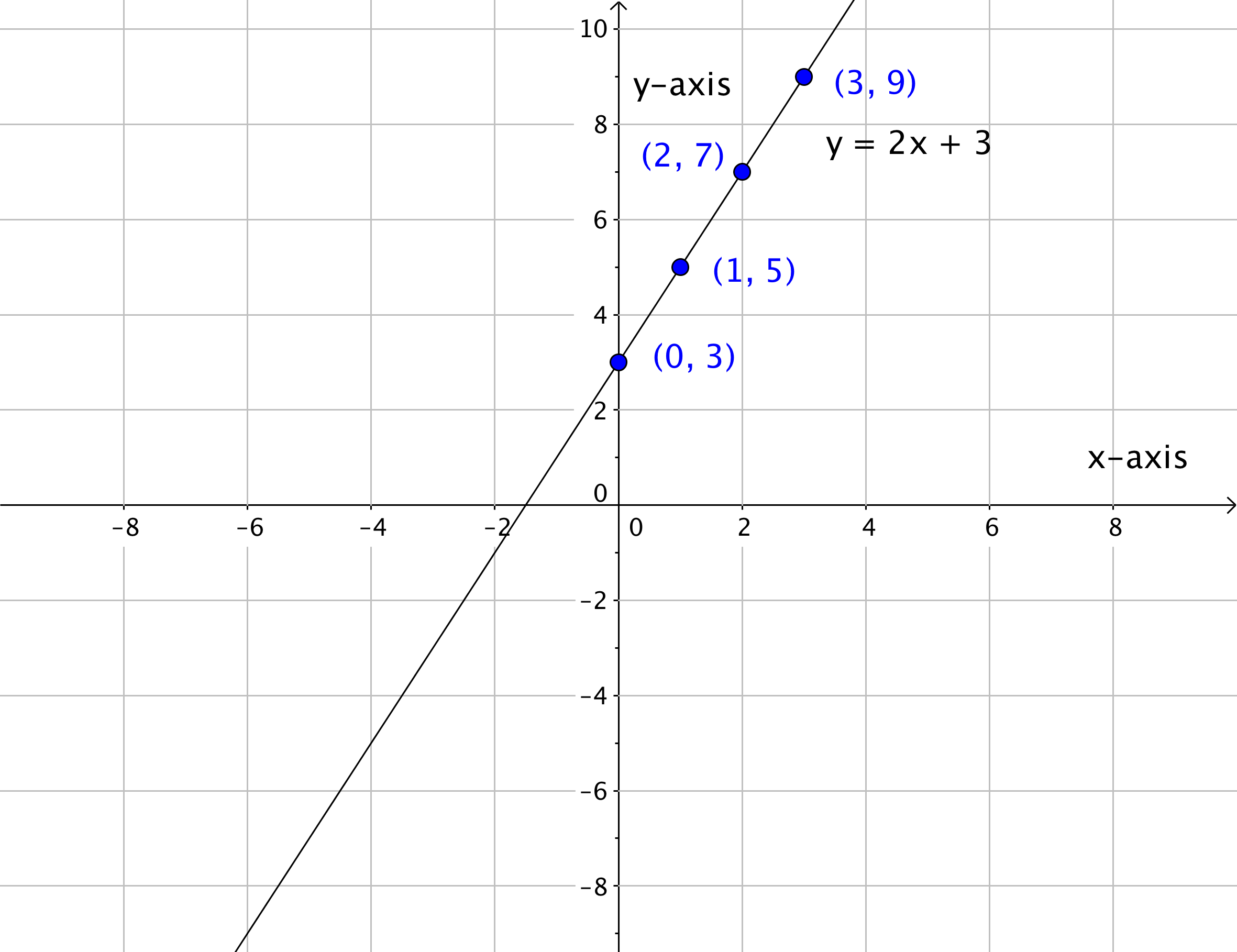
Ordered Pairs as Solutions
So far, you have considered the following ideas about lines: a line is a visual representation of a linear equation, and the line itself is made up of an infinite number of points (or ordered pairs). The picture below shows the line of the linear equation [latex]y=2x–5[/latex] with some of the specific points on the line. Every point on the line is a solution to the equation [latex]y=2x–5[/latex]. You can try any of the points that are labeled like the ordered pair, [latex](1,−3)[/latex].
Every point on the line is a solution to the equation [latex]y=2x–5[/latex]. You can try any of the points that are labeled like the ordered pair, [latex](1,−3)[/latex].
[latex]\begin{array}{l}\,\,\,\,y=2x-5\\-3=2\left(1\right)-5\\-3=2-5\\-3=-3\\\text{This is true.}\end{array}[/latex]
You can also try ANY of the other points on the line. Every point on the line is a solution to the equation [latex]y=2x–5[/latex]. All this means is that determining whether an ordered pair is a solution of an equation is pretty straightforward. If the ordered pair is on the line created by the linear equation, then it is a solution to the equation. But if the ordered pair is not on the line—no matter how close it may look—then it is not a solution to the equation.Identifying Solutions
To find out whether an ordered pair is a solution of a linear equation, you can do the following:- Graph the linear equation, and graph the ordered pair. If the ordered pair appears to be on the graph of a line, then it is a possible solution of the linear equation. If the ordered pair does not lie on the graph of a line, then it is not a solution.
- Substitute the (x, y) values into the equation. If the equation yields a true statement, then the ordered pair is a solution of the linear equation. If the ordered pair does not yield a true statement then it is not a solution.
Example
Determine whether [latex](−2,4)[/latex] is a solution to the equation [latex]4y+5x=3[/latex].Answer: For this problem, you will use the substitution method. Substitute [latex]x=−2[/latex] and [latex]y=4[/latex] into the equation.
[latex]\begin{array}{r}4y+5x=3\\4\left(4\right)+5\left(−2\right)=3\end{array}[/latex]
Evaluate.[latex]\begin{array}{r}16+\left(−10\right)=3\\6=3\end{array}[/latex]
The statement is not true, so [latex](−2,4)[/latex] is not a solution to the equation [latex]4y+5x=3[/latex].Answer
[latex](−2,4)[/latex] is not a solution to the equation [latex]4y+5x=3[/latex].Intercepts
The intercepts of a line are the points where the line intercepts, or crosses, the horizontal and vertical axes. To help you remember what “intercept” means, think about the word “intersect.” The two words sound alike and in this case mean the same thing. The straight line on the graph below intercepts the two coordinate axes. The point where the line crosses the x-axis is called the x-intercept. The y-intercept is the point where the line crosses the y-axis. The x-intercept above is the point [latex](−2,0)[/latex]. The y-intercept above is the point (0, 2).
Notice that the y-intercept always occurs where [latex]x=0[/latex], and the x-intercept always occurs where [latex]y=0[/latex].
To find the x- and y-intercepts of a linear equation, you can substitute 0 for y and for x respectively.
For example, the linear equation [latex]3y+2x=6[/latex] has an x intercept when [latex]y=0[/latex], so [latex]3\left(0\right)+2x=6\\[/latex].
The x-intercept above is the point [latex](−2,0)[/latex]. The y-intercept above is the point (0, 2).
Notice that the y-intercept always occurs where [latex]x=0[/latex], and the x-intercept always occurs where [latex]y=0[/latex].
To find the x- and y-intercepts of a linear equation, you can substitute 0 for y and for x respectively.
For example, the linear equation [latex]3y+2x=6[/latex] has an x intercept when [latex]y=0[/latex], so [latex]3\left(0\right)+2x=6\\[/latex].
[latex]\begin{array}{r}2x=6\\x=3\end{array}[/latex]
The x-intercept is [latex](3,0)[/latex]. Likewise the y-intercept occurs when [latex]x=0[/latex].[latex]\begin{array}{r}3y+2\left(0\right)=6\\3y=6\\y=2\end{array}[/latex]
The y-intercept is [latex](0,2)[/latex].Using Intercepts to Graph Lines
You can use intercepts to graph linear equations. Once you have found the two intercepts, draw a line through them. Let’s do it with the equation [latex]3y+2x=6[/latex]. You figured out that the intercepts of the line this equation represents are [latex](0,2)[/latex] and [latex](3,0)[/latex]. That’s all you need to know.
Example
Graph [latex]5y+3x=30[/latex] using the x and y-intercepts.Answer: When an equation is in [latex]Ax+By=C[/latex] form, you can easily find the x- and y-intercepts and then graph.
[latex]\begin{array}{r}5y+3x=30\\5y+3\left(0\right)=30\\5y+0=30\\5y=30\\y=\,\,\,6\\y\text{-intercept}\,\left(0,6\right)\end{array}[/latex]
To find the y-intercept, set [latex]x=0[/latex] and solve for y.[latex]\begin{array}{r}5y+3x=30\\5\left(0\right)+3x=30\\0+3x=30\\3x=30\\x=10\\x\text{-intercept}\left(10,0\right)\end{array}[/latex]
To find the x-intercept, set [latex]y=0[/latex] and solve for x.Answer

Example
Graph [latex]y=2x-4[/latex] using the x and y-intercepts.Answer: First, find the y-intercept. Set x equal to zero and solve for y.
[latex]\begin{array}{l}y=2x-4\\y=2\left(0\right)-4\\y=0-4\\y=-4\\y\text{-intercept}\left(0,-4\right)\end{array}[/latex]
To find the x-intercept, set [latex]y=0[/latex] and solve for x.[latex]\begin{array}{l}y=2x-4\\0=2x-4\\4=2x\\x=2\\x\text{-intercept}\left(2,0\right)\end{array}[/latex]
Answer
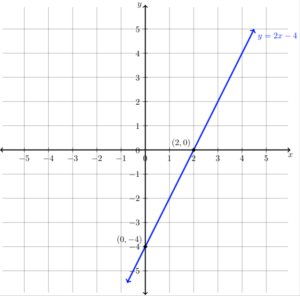
Licenses & Attributions
CC licensed content, Original
- Authored by: Quadrants on the Coordinate Plane. License: CC BY: Attribution.
CC licensed content, Shared previously
- Graph Basic Linear Equations by Completing a Table of Values. Authored by: James Sousa (Mathispower4u.com) . License: CC BY: Attribution.
- Determine If an Ordered Pair is a Solution to a Linear Equation. Authored by: James Sousa (Mathispower4u.com) . License: CC BY: Attribution.
- Plot Points Given as Ordered Pairs on the Coordinate Plane. Authored by: James Sousa (Mathispower4u.com). License: CC BY: Attribution.
